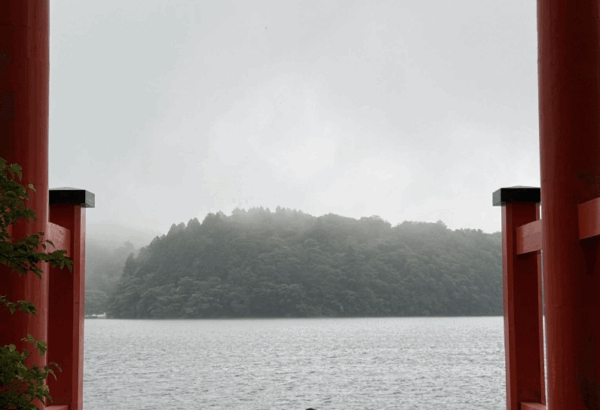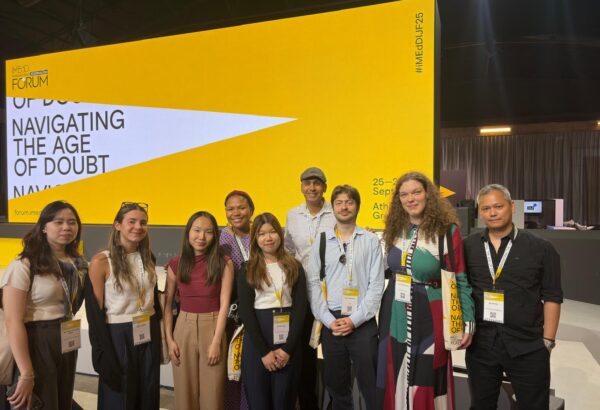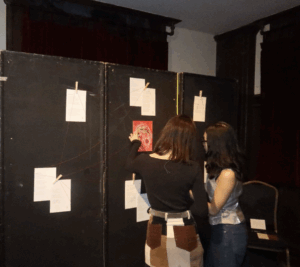 This past spring, in an effort to enlarge the circle and share our work and ideas with a larger audience of friends and peers, we organized Circle Gathering. We continued with the non-hierarchical ethos for the event and invited participation with four interactive pieces. One included instructions to find a friend, use their back as a table, and draw them. Everyone was invited to hang their results on the wall. For another piece, one artist asked everyone to write down a secret on a slip of paper. He then cut up the words and pasted them onto a board to create a poem. Another artist showed an installation based on memory that included painting and poetry in the form of a constellation. She asked everyone to write down what memories it sparked for them.
This past spring, in an effort to enlarge the circle and share our work and ideas with a larger audience of friends and peers, we organized Circle Gathering. We continued with the non-hierarchical ethos for the event and invited participation with four interactive pieces. One included instructions to find a friend, use their back as a table, and draw them. Everyone was invited to hang their results on the wall. For another piece, one artist asked everyone to write down a secret on a slip of paper. He then cut up the words and pasted them onto a board to create a poem. Another artist showed an installation based on memory that included painting and poetry in the form of a constellation. She asked everyone to write down what memories it sparked for them.
The fourth piece included three pods of chairs, each with a question that everyone was invited to discuss to encourage intellectual and artistic exchange grounded in experience and connection. The questions included “What’s the first work of art (any type!) you loved as a kid?” and “Which of your senses are most stimulated here?” Both the interactive pieces and pods allowed us to blur the difference between Circle Collective artists and our guests.
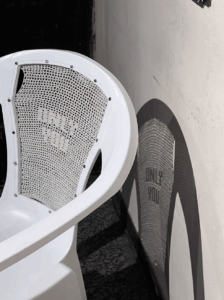
As inspiration for Circle Gathering, we looked to artworks by artists working in a variety of media. A highlight for me was recreating Yoko Ono’s Scream Symphony by inviting everyone to scream at the top of their lungs for ten seconds. The ability to express intense emotions together allowed us to feel more comfortable being silly and vulnerable. We also discussed a work called 1952 Theater Piece No. 1 by several artists: David Tudor, M.C. Richards, Charles Olson, Robert Rauschenberg, John Cage, and Merce Cunningham, performed in the dining hall of Black Mountain College. Some accounts say Tudor played the piano, Richards and Olson read poetry, Rauschenberg displayed his white paintings on the ceiling and played records, Cage spoke about Zen Buddhism, and Cunningham danced while a dog chased him. The Circle Gathering had similarities to these in that they were multidisciplinary and art was happening and being experienced together.
The pods of chairs were inspired by Eleonora Fabião’s Triptych Miami, in which she set up chairs in a circle on the street in Miami with a sign saying “I Will Have a Conversation About Any Subject.” Another work titled Live in Your Head – When Attitudes Become Form, the 1969 exhibition at Kunsthalle Bern curated by Harald Szeemann, included many artists who created their works on-site and in the weeks leading up to the exhibition. The focus was on the process of creation, the interactions between the different artworks in partnership with the curator.
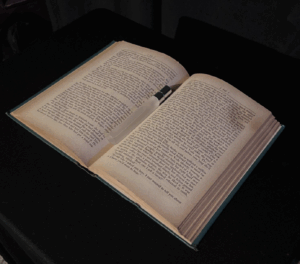
As an SNF Paideia Fellow, I’ve had the opportunity to explore new ways of communicating that allows for more voices and conversations. Circle Collective has been a way to put these ideas into practice. Something that surprised me about the Collective was how open and vulnerable people were with eachother. This aligns with a lesson from Paideia that I take away with me as I graduate, that it is important to build communities where dialogue is grounded in openness and respect. This is a reminder that I shared in my opening remarks at Circle Gathering that “All of us here are tied together with a golden string already” and encouraged everyone to chat and get to know one another.” Circle Gathering reminded me of the value of creating space to share art and thought, and I hope to continue finding and creating new ways to communicate and learn from each other.
Sofia Gutierrez Boker (W’25), Finance and Business, Energy, Environment, & Sustainability



